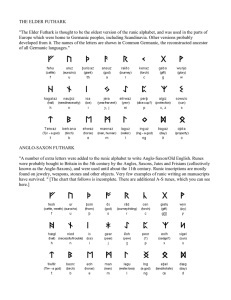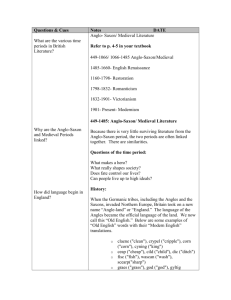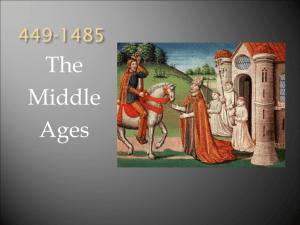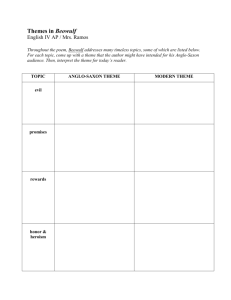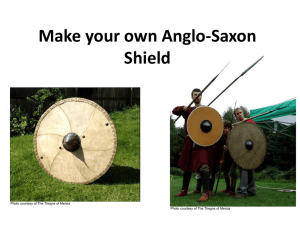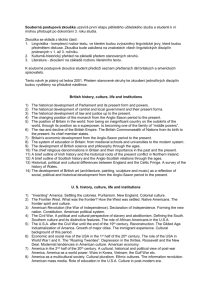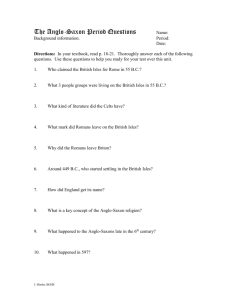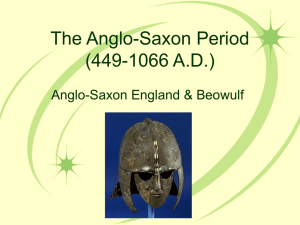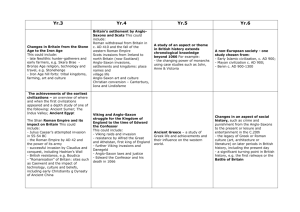File
advertisement
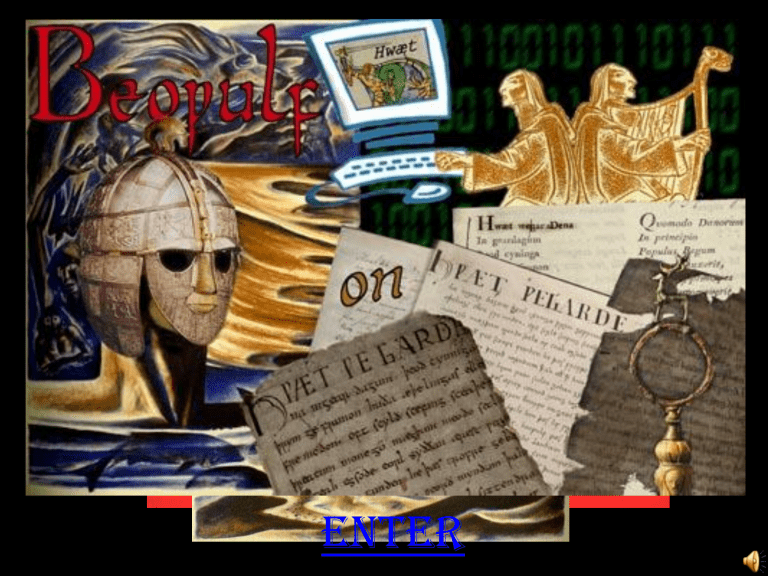
Beowulf Enter Your training willthe consist ofwarriors. four tasks: When our chief saidofhe needed more warriors, I did IOnce ambeginner Bealdric, head chief’s It is my you complete these tasks, you will be granted learning the history ofrecruit our culture, studying theways not expect himtoto unskilled civilians! But you responsibility train you and teach you the of Grab your shield and we’ll begin! the title of Anglo-Saxon Warrior! various conquests willAnglo-Saxons. have to do… of Britain, learning about our the writings and songs, and creating a personal shield. Tasks: Complete in Order 1. History / Notes 2. Maps You will fill in your outline You will complete this task with historical facts. while completing Task 1. 3. Anglo-Saxon Writings You will become familiar with out writings. 4. Personal Shield History / Notes As youMake go through sure you the are following filling inslides, your historical newbie, make sure you haveand thewriting volumedown turned on. Yourashistory outline questions they guidecome will give additional explanations the lesson. to you. We always give ourto rookies tests! Early Britain was filled with numerous Celtic tribes, known as the Britons. They were illiterate semi-nomadic farmers, hunters, and fisherman. They worshipped thousands of woodland spirits. Their priests, known as Druids, were also their doctors, teachers, and prophets. • Julius Caesar began raids on Britain in 55 B.C. It wasn’t until A.D. 43 that Rome established permanent rule. Roman occupation lasted until the year 410. • In The Dark Ages, Rome, who had already conquered the country, attempted to “Romanize” the Britons, introducing towns, villas, roads and forts, as well as Hadrian’s Wall, designed to keep out the Picts. Hadrian’s Wall • During Roman inhabitance, Britain was being plundered and raided by Germanic tribes, the Angles , Saxons, and Jutes. • These Germanic tribes made war the main object of their existence and were very fierce in battle. When not fighting, they were heavy eaters and drinkers. They seem to have been the victims of dark melancholy; therefore, light, happy moods do not exist in their poetry and songs. • Britons, perhaps led by a Celtic chieftain named Arthur, fought against these invaders, but were driven away. See map of conquest. • Generally, it is agreed that by A.D. 449, these Germanic tribes had completely infiltrated the country. Thus, the main part of Britain became known as Angle-land, or England. • The country was then divided up into seven kingdoms. • The Anglo-Saxon culture became the basis of the English culture, and their Germanic language became the language of Angle-land now known as Old English. Map 1: Map of Conquests in 500 A.D. Use this time to complete Task 3. Copy this map unto your blank one. Map 1: Map of the Seven Kingdoms Use this time to complete Task 3. Copy the seven kingdoms on this map unto your blank one. • About the end of the eighth century, Vikings from Denmark, referred to as the Danes, attacked and eventually settled in Angle-land as well. • In 1066, William, duke of Normandy, France, led the last successful invasion on the island of Britain, the Norman Conquest, which ended Anglo-Saxon dominance. Map 2: Overview of all the conquests throughout the history of Britain. Use this time to complete Task 3. Copy the conquests from this map unto your blank one. Irish (450 A.D.) French (1066 A.D.) General Outline of Conquests Pre A.D. 43 Celts inhabited Britain A.D. 43 Romans establish dominance A.D. 410 Romans leave A.D. 449 Germanic peoples settle in Britain A.D. 994 Danes invade and Canute becomes king A.D. 1066 William of Normandy invades and becomes king You have just received training on the Youvery learngeneral quickly! This isofgood. We need overview the history of ourwith language our people. warriors greatand intelligence! Keep this in mind as you begin studying our writings. You may continue with your tasks, rookie. Maps During your first task, have If you are finished withyou theshould geography completed twolesson, different maps. You must session of our move on to Task 3. know about the territory in which we live if you wish to defend it. Anglo-Saxon Writings In order to fight with us, you must understand our culture. This includes our style of writing. Learn about the following: 1)What Old English looks and sounds like 2)What elements of literature are typical of our time period Runes • The earliest British inhabitants, of whom we have written history, were the Celts. They used a form of writing called runes. • Runes were carved into trees, stones, crosses, etc. Many of these can still be seen today. Celtic Runes Old English (450-1100 AD) The invading Germanic tribes spoke similar languages, which in Britain developed into what we now call Old English. Old English did not sound or look like English today. Native English speakers now would have great difficulty understanding Old English. Nevertheless, about half of the most commonly used words in Modern English have Old English roots. The words be, strong, and water, for example, derive from Old English. Old English was spoken until around 1100. Old English: The first page of Beowulf 1) Study the copy. 2) Write down your impressions of Old English based on the writing. Old English • Go to http://faculty.virginia.edu/OldEnglish/Beowulf.Readi ngs/Prologue.html • Next, click on the line numbers to hear a reading. What is your impression of Old English based on the audio? • Next go to http://www.1066andallthat.com/english_old/lords_ prayer.asp • Listen to the first video and follow along with the Old, Middle, and Modern English listed below the video. What words and patterns are similar? What is different? Be specific. Old English Riddles • Many Old English writings contain riddles similar to the ones we have today. Go to the following website: http://www.swarthmore.edu/Humanities/english /oldenglish/ • Read Week 2: Riddle 76. Answer these two questions: 1)In the riddle, who/what is the speaker? (Hint: It’s an inanimate object.) 2)What is the object’s function? (Hint: Two are given in the riddle.) The following literature terms are present in Beowulf. Therefore, you need to be able to know, recognize, and use them. Stock Epithets • Adjectives that point out special traits of particular persons or things • “swift-footed” used to describe Achilles in the Iliad • to describe Achilles in the Iliad Kennings • A descriptive phrase or compound word that substitutes for a noun • “sin stained demon” in place of Grendel’s name Alliteration • The repetition of the first consonant sound in a phrase • Example: • Tongue twisters: Sally sells sea shells by the sea shore • This method was used by scops for memorizing many lines of poetry. caesura • A pause dividing each line, with each part having two accented syllables U / U U / U / U • “He took what he wanted, // all the / U treasures.” Good! knowledge our YouYou maynow nowhave complete your shield history, geography, and writings. to show off the honor that youIt is time for you to become a true Anglo-Saxon have earned. warrior! Personal Shield Traditionally, Anglo-Saxon shields were round and made of wood. They were often decorated with artistic elements which represented the warrior. You have been given a shield from from your teacher. Complete the following steps to make it unique. Shield Directions 1) Go to the following website: Runic Name. Learn how to write your name in the runic alphabet. This should be written on your shield along with the Modern English translation. 2) Go to the following website: Runic Symbols. Choose two runic symbols that represent you. These should be written on your shield along with the Modern English translation. 3) Decorate the rest of the shield in a way that reflects yourself. There should be no white space left. 4) On the back, explain the symbols and other decorations you chose to use. You are now my friend, Incredibly awesome Powerpoint Congratulations! Now that but youthat have does mean will share completed yourI tasks, you my are a true provided by: notall mead withwarrior! you! See you in the Anglo-Saxon mead hall! Your incredibly awesome teacher!
